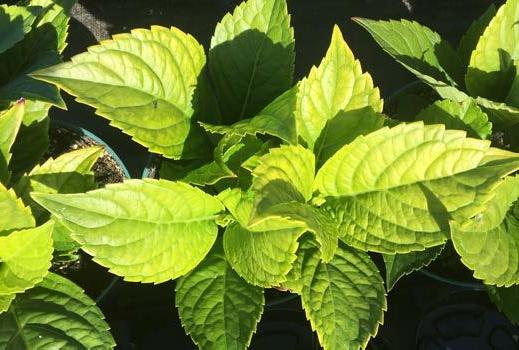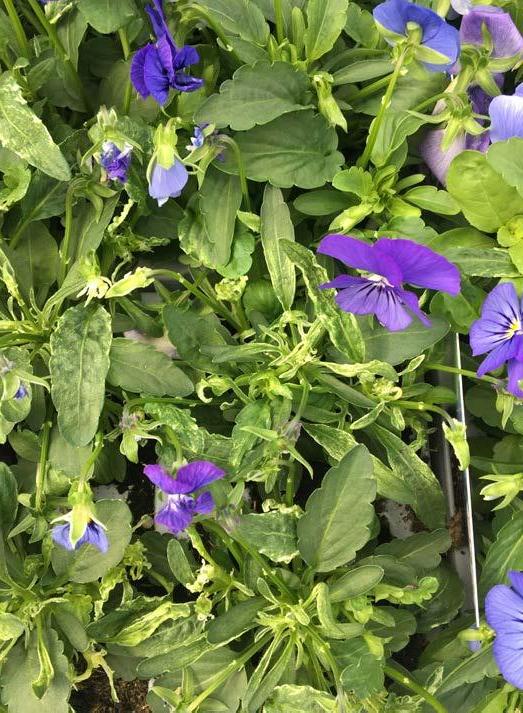
5 minute read
Production systems
Chemical free growth control
AHDB project code: PO 022 Developing precision and deficit irrigation techniques to reduce reliance on plant growth regulators and to optimise plant quality, uniformity and shelf-life potential in commercial protected pot and bedding plant production Term: June 2019 to March 2023 Project leader: Mark Else, NIAB EMR
Advertisement
As a result of revocations, only a single plant growth regulator product containing chlormequat (Stabilan 750) is now available for use on poinsettias, and this product can only be used at a reduced rate and frequency. Other AHDB-funded trials (PO 019a) are examining alternative products in the short term, but in the medium to long term a method of growth control not involving plant growth regulators is required to permit the continued commercial production of poinsettias in the UK.
The project Previous AHDB-funded work (PO 21 and PO 21a) identified that regulated deficit irrigation can be used to control stem height in poinsettias, which, with the help of growing media moisture sensors and data loggers, demonstrated that it is possible to control growth without reliance on plant growth regulators. However, further work is required to optimise this approach on poinsettia, and potentially extend it to other crops, and to include other approaches so that the industry has a suite of options to use.
Poinsettia water deficit event
Results Regulated deficit irrigation was once again applied successfully to control the growth of poinsettias grown on flood benches, even at the commercial scale of application employed at Neame Lea Nurseries in Lincolnshire. The plants were monitored using graphical tracking to keep them within the required product specification. However, differences in varietal response were noted, and it appears that the procedure cannot be applied with the same level of success across all varieties.
During the trial, other practical aspects of the system were examined, this included confirming the suitability of the equipment used, testing the user interface and looking at the uniformity of the irrigation system employed so that a consistent stress could be applied across the crop.
The sensors, data loggers and telemetry used in the trial proved reliable and worked well. Remote access to real-time data improved decision making, and the grower dashboard user interface displayed a range of important data in an easily digestible format. Differences in the irrigation performance of the various systems used was noted. Variations in plant and pot weight (before and after irrigation) on the flood benches and benches with capillary matting were judged to be minimal and many of the issues could be addressed. However, capillary matting laid onto ground beds proved to be more variable, impacting the uniformity of stress applied.
In terms of shelf life, plants exposed to regulated deficit irrigation during production tended to have improved shelf-life performance.
AHDB project code: HNS 200 Developing nutrient management guidance for hardy nursery stock Term: April 2019 to March 2022 Project leader: Jill England, ADAS

AHDB project code: PO BOF 003 Nutrient management for protected ornamentals, bulbs and outdoor flowers Term: September 2018 to December 2022 Project leader: Hilary Papworth, NIAB
Iron deficiency in Hydrangea

A wide range of fertiliser types are used to provide plant nutrition for ornamentals crops. Water-soluble and foliar fertilisers provide an almost instant supply of nutrients to the plant; base and compound fertilisers provide nutrition over a period of weeks or months; while slow- and controlled-release fertilisers can supply nutrients for up to 18 months.
Although rates are available in manufacturers’ technical information, there is no guidance in the current edition of the Nutrient Management Guide (RB209) for hardy nursery stock and protected ornamentals – the most recent recommendations being published in the 1988 edition.
As a result, there is potential for improved nutrient management practices to better control growth and scheduling and reduce potential nutrient loss from container-grown crops.
The projects Project HNS 200 will focus on collating and generating data to provide nutrient management recommendations and best-practice guidance. Controlled-release and water-soluble fertiliser use in container-grown crops will be examined, particularly for plants grown over more than one season, either under protection or outdoors. Basic information on the nutrient requirements of field-grown trees at different growth stages will also be collected. Equipment to monitor plant nutrient status will be compared to improve monitoring, timing and application of fertilisers.
Project PO BOF 003 aims to improve nutrient management guidance for key crop types and growing systems within protected ornamental, bulb and outdoor flower production. New information will be generated to update and enhance the protected ornamentals section of the Nutrient Management Guide (RB209).
The project will address areas relating to delivery of nutrients to pot and bedding plants; managing the nutrient requirements of plants at different growth stages; nutrition within hydroponics; the effects of nitrate and ammonium as nitrogen sources; nutrient management for holding plug plants and crate-grown lilies; nitrogen applications to narcissus bulb flowers; the role of nutrient deficiencies in primrose leaf edge scorch; and current and novel approaches to plant nutrient monitoring.
AHDB project code: PO 024 Investigating the causes of pansy mottle syndrome (PaMS) Term: June 2019 to May 2020 Project leader: Jill England, ADAS
Pansy mottle syndrome is a physiological condition which has been reported since the 1960s. Typical symptoms include leaf distortion, mottling, leaf bleaching, stunting and apical blindness. The extent may vary from year to year on nurseries. Determination of the cause is complicated by the transient and intermittent nature of plant response, difficulty in replicating the symptoms and linking the cause with effect. Incidence has increased in recent years, prompting the need for more work to determine the influences on occurrence within the industry.
The project This project aims to improve understanding of the environmental conditions that trigger pansy mottle syndrome symptoms through environmental monitoring of commercial-grown pansy crops, using wireless environmental sensor systems to predict plant stress. Analyses of data from these sensors will be used to determine the correlation between environment events and symptom expression. Gravimetric techniques will be used to determine the irrigation requirements of pansy plugs, which will be subjected to five irrigation regimes to demonstrate the implementation of best practice to avoid symptoms.






